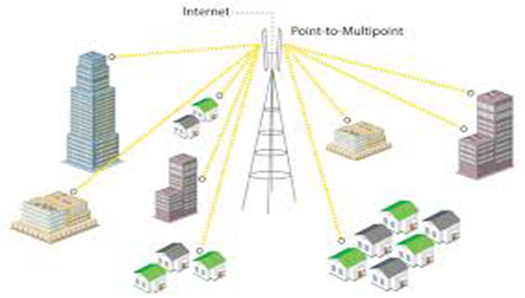P2MP is communication which is accomplished via a distinct type of one-to-many connection, providing paths from a single location to multiple.
Point to Multipoint Location
Point to multipoint communication involves a distinct type of one-to-many connections that allows for multiple paths from one single location to multiple locations. The technology is a popular approach for wireless communications that have a large number of end destinations or end users.
Point-to-point connections involve a single dedicated link—there is only one transmitter and one receiver. On the other hand, point to multipoint connections involves two or more devices sharing a single link. There is only one transmitter, but there can be multiple receivers. With the technology, the receivers are able to get messages from the transmitter, but receivers do not communicate with each other. They only send messages back to the main transmitter.
Point to multipoint connectivity is a common practice for wireless service providers, which place radio transmitters on top of buildings or hills that have a clear line of sight to multiple receiving radios. The connectivity typically operates on both unlicensed and licensed frequencies with speeds of up to 1 gigabits per second.
The technology is often used for establishing connectivity to facilities in remote locations and in long-range wireless solutions. It is widely used in applications for industries that cover a wide area of space, such as school districts, public safety areas, and large manufacturing facilities. The only requirement for the receiver sites is that they have to be within the range and visibility of the base station.

Benefits of point to multipoint connectivity
Many businesses choose this technology over point-to-point connections because it is:
- Easy to install – It is easier to add users in a multipoint connection, instead of creating a series of individual connections.
- Relatively low cost – Because multipoint connections can be easily added, there is less cost associated with cables and installation. Plus, because it’s WiFi, it can help your business avoid the expense of wired connections, zoning requirements, permits and fees.
- Reliable – Users are not monopolizing channels, but sharing one communication link, which makes the connection more reliable. This also means there is no need to regulate or manage who is allowed to transmit at any time, which helps monitor communication.
In one example, the A2J Point-to-Multipoint is a field-proven, secure, and flexible wireless broadband solution. It offers network operators new alternatives in terms of range, coverage, throughput, scalability, and latency. It is also suited for building new networks, offering green field operators a significantly lower cost, and providing a higher return than many other solutions.
Many wireless solutions employ a combination of point-to-point and point-to-multipoint technology to create the fastest and most efficient coverage, and to maximize wireless technology, which is always improving. Wireless networks that provide point to point and point to multipoint connectivity cost less over time by eliminating recurring charges by the phone company.
-
- Reliable – Users are not monopolizing channels, but sharing one communication link, which makes the connection more reliable. This also means there is no need to regulate or manage who is allowed to transmit at any time, which helps monitor communication.
In one example, the A2J Point-to-Multipoint is a field-proven, secure, and flexible wireless broadband solution. It offers network operators new alternatives in terms of range, coverage, throughput, scalability, and latency. It is also suited for building new networks, offering green field operators a significantly lower cost, and providing a higher return than many other solutions.
Many wireless solutions employ a combination of point-to-point and point-to-multipoint technology to create the fastest and most efficient coverage, and to maximize wireless technology, which is always improving. Wireless networks that provide point to point and point to multipoint connectivity cost less over time by eliminating recurring charges by the phone company.


